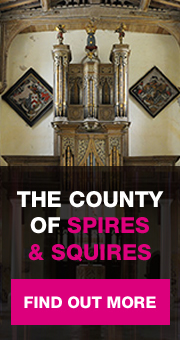St Mary’s Church is all that remains of the Medieval village of Easton Neston when, following the enclosure of the land, the village was transferred to Hulcote. The church stands adjacent imposing Easton Neston House, designed by Nicholas Hawksmore for the Fermor- later Hesketh – family. The building is a beautiful early mediaeval church The most outstanding feature is the 16th century chancel memorial to Sir George Femor and his wife. There are a number of other monuments to the Fermor- Hesketh family around the church. The re building of the house circa 1700 affected the church with a new pulpit and box pews. The church is full of memorials to the Fermor family (The Earls of Promfret) and later to the Fermor Heskeths (The Lords Hesketh). The earliest are to be found in the chancel. Here you find a panelled tomb chest to Richard Fermor (died 1552) who bought the estate from the Crown after the attainder of Henry VII’s minister Richard Empson. Fermor had made a fortune out of wool which will be a recurring theme on this tour. The brasses on top of the chest are a palimpsest of earlier brasses reassembled here. Opposite is the flamboyant tomb to his grandson, Sir George Fermor and his wife Mary Curson. This is attributed to Jasper Hollemans, the son of Garret Hollemans who had come to England circa 1580 and established the family at the alabaster quarries at Burton on Trent. Jasper’s few surviving works are best seen in Northamptonshire, here and at Great Brington (he was also responsible for the Spenser tomb at Yarnton near Oxford and the Bassett tomb at Blore in Staffordshire). Here, working in fine soft alabaster, partly painted and gilded, he created a spectacular funerary show topped by a huge peacock’s tail of ornamental panels separated by pennons. Elsewhere are columns, obelisks, allegorical figures and heraldic achievements, whilst around the base the Fermor children kneel in relief. Note Mary Curson’s fine head dress and Sir George’s helmet, topped with the Fermor family crest of a cockerel. On the opposite wall is the memorial of Sir Hatton Fermor and his wife Anne Cockayne, daughter and heiress of the Lord Mayor of London who owned Rushton Hall in the north part of the County. The memorial also includes their eldest son who died the year before it was erected and three of his sisters who appear as half length sculptures along the top, as if sitting in an opera box. This monument because it eventually had to commemorate not two but six people, is somewhat odd in design, but the execution is rather good. Note the swaggering boots of Sir Hatton, who stands to one side, his wife on the other. It is attributed to Pierre Besnier (c. 1630-1693) probably a Huguenot refugee who worked with his brothers under Hubert Le Soeur for Charles I. The civil war clearly affected his career but by the late 1650s he had re-established himself, creating the Shuckbrugh monument in Warwickshire, very like this tomb, and was carving the armorials on the façade of Lamport Hall. Besnier’s busts of the sitters that were formerly at Easton Neston are now owned by Northampton Art Gallery. Lastly in the chancel, to the left of the altar, is E H Baily’s large wall monument to the 3rd Earl of Pomfret (d. 1830) showing his lordship beside a huge funerary urn. Baily was presumably also engaged at the same time on his large figure of Minerva who, resplendent in gold leaf, sits aloft the entrance to the Athenaeum. Later, he was to provide Nelson for his column in Trafalgar Square. Note also the accomplished gothic wall plaque to Thomas Hatton Fermor (d. 1864) a noted early photographer. Off the chancel is the memorial chapel to more recent members of the Fermor Hesketh family approached through wrought iron gates that formerly stood in the entrance hall of the house. The walls are covered with a variety of tablets: the Anglo-American ancestry of the family revealed in their inscriptions. Particularly notable is the great neo-georgian aedicule to the 1st Lord Hesketh who died in 1944. An unusually large and imposing tomb for the period. An equally impressive alabaster tomb to his son the 2nd Lord Hesketh, an unusual arrangement of geometric shapes, stands at the rear of the north aisle. As you leave the church there are two further wall tombs of particular beauty. The first has been attributed to Sir Francis Chantrey, but there is no evidence to support this and it may be another by Baily to the 2nd Earl and Countess of Pomfret with their children weeping at their loss. This is rather odd when you consider that it seems to have taken those children 30 years to put up the memorial. The Earl died in 1785, his wife two years later, and yet the tomb dates from 1816. Another conundrum, is who is the other man conspicuous here? Nearby, another work by Baily, this time to the 2nd Earl’s daughter Lady Charlotte with her husband, Peter Denys and their daughter, also called Charlotte. Rather touchingly the memorial is initialled so you know who is commemorated where: LCD (Lady Charlotte Denys), CD (Charlotte Denys), PD (Peter Denys) – not I think a common practice.
Please refer to the Glossary for any terms in the text that you are unfamiliar with.







